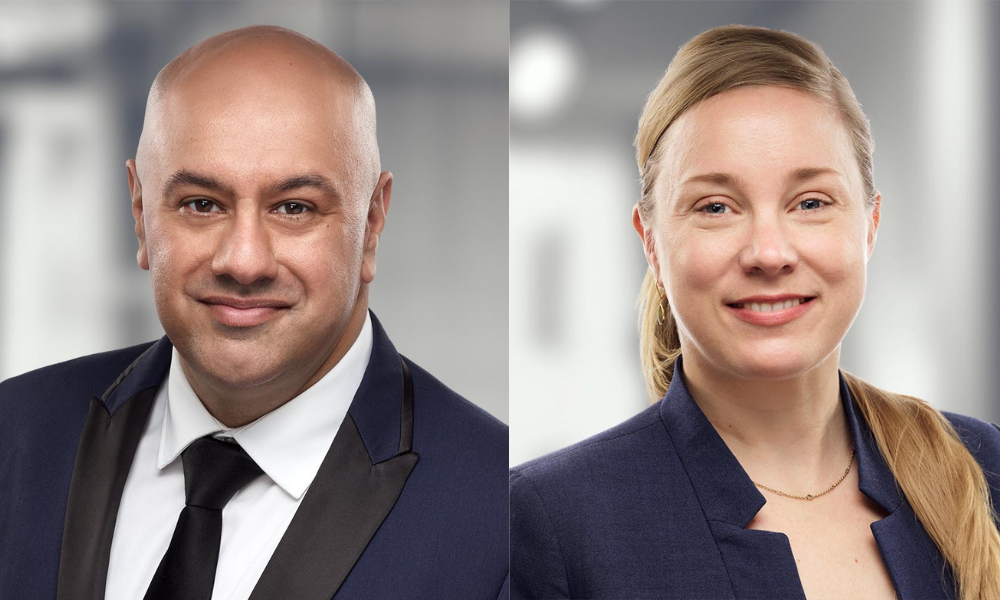
Tech experts at the firm explain why good AI isn't enough – it needs to work for lawyers

A successful AI technology pilot in a law firm requires more than a promising tool – it needs the right culture and collaboration across departments, say technology lawyers from Torys LLP.
The firm, which won the 2024 LEAP Legal Software Award for Best Use of Technology in a Law Firm, has developed a repeatable process for evaluating, piloting, and implementing new technology.
According to Sukesh Kamra, who leads Torys’ knowledge and innovation team, and Jessica Lumiere, a senior lawyer in the firm’s Legal Services Centre in Halifax, the key to successful implementation is to prioritize people and processes before the product.
Kamra says the most important element in adopting new technologies is creative problem-solving.
“When you have lawyers [who] are open-minded like we have, then you can encourage them to help you find more efficient and effective ways to practise law. It can be through project management, or better use of innovative technology, or just better ways to communicate internally.”
Kamra says it’s easier to assess what legal professionals need in such an environment than to assume or guess.
“Instead of jumping to the solution and then trying to find what the pain point is, we go to our people… and say, what are we trying to solve for here? Have we tried to solve for this in the past? And if we did, what did we learn so that we can improve on that?”
The next step is assessing whether a solution already exists within the firm or whether they need to turn to an outside vendor. Kamra says compliance is a major factor at this stage.
“We work very closely with our risk management team as well as our information services team to ensure we have check-marked the boxes around information security and our strategy at the firm.”
Kamra says Torys first pilots the product internally, paying close attention to whether it fits into the firm’s existing workflows. This stage is essential for him since many tools look good on the surface but don’t integrate well in practice.
“You'll have a solution that looks great, and the demo looks really good… but does it work for us?” he says.
“We're asking our people to move away from the way they've been doing something… The delta between the way we're doing it now… versus how we're going to be doing it with generative AI has to be big enough for us to say, yes, we're going to take that leap.”
Lumiere says the key is to show lawyers that the solution will make a visible change, like decreasing non-billable hours or making selling services easier.
“We have to be able to sell it to the lawyers as something that is [to] their benefit, not the firm's benefit.”
Lumiere says Torys's one advantage is its tech-savvy team in Halifax, which often takes the lead on pilot programs. That, she adds, makes a big difference when rolling out complex tools like AI.
“It's hard to just sit down a regular sort of lawyer and say, hey, guess what? You're going to learn how to train an AI tool now… that's maybe a lot to ask.”
She says these tech-forward lawyers provide critical feedback during the pilot phase, helping the firm refine tools before wider deployment.
“By the time the lawyers get it in the other offices, it's already had some of those quirks smoothed out.”
Kamra says Torys often works directly with clients to share insights from its pilots or even co-create tailored solutions.
“Oftentimes, that means Jessica's team and my team will work together very closely with the client to create that path and work hand in hand to create the solution, or frankly, just to provide our expertise on a pilot that we ran to say, here's what worked well and here's what did not work well,” he adds.
Torys uses AI in two core areas: document-heavy work such as due diligence and contract analysis and business productivity tools.
Kamra and Lumiere say the firm is closely watching developments in generative AI and large language models but add that the technology is still in its early stages.
“We haven't had that watershed moment of generative AI at this stage because every day, there’s a new large language model or a new use case. The art of the possible is growing tremendously quickly,” Kamra says.
Still, Kamra and Lumiere acknowledge that AI adoption in law faces significant hurdles. One is resistance to change.
“There are two kinds of people – people who are very curious… and then there's a group of people that are just like, please God, don't throw another thing at me,” Lumiere says.
Another challenge is AI’s reliability. Kamra says that accuracy and reliability are paramount in law.
“We have to be consistent in our advice… and we have to be able to defend it. In other words, we have to be right in what we say to our clients. Generative AI… doesn’t always get it right… and to me, that’s the biggest obstacle.”
He adds that generative AI’s outputs are more challenging to predict or explain than traditional machine learning.
“With generative AI, we don’t really know how it works in the back end,” Kamra says.
That unpredictability fuels a common misconception – that AI shouldn’t be used at all if it can be wrong. Kamra, instead, sees value in narrowing its use to areas where lawyers can step in to verify results.
Kamra was one of Canadian Lawyer’s Top 25 Most Influential Lawyers in 2024. Nominations for the 2025 list are now open.